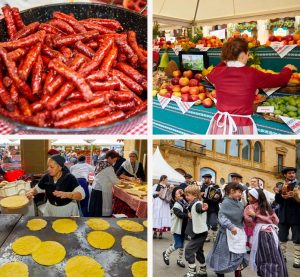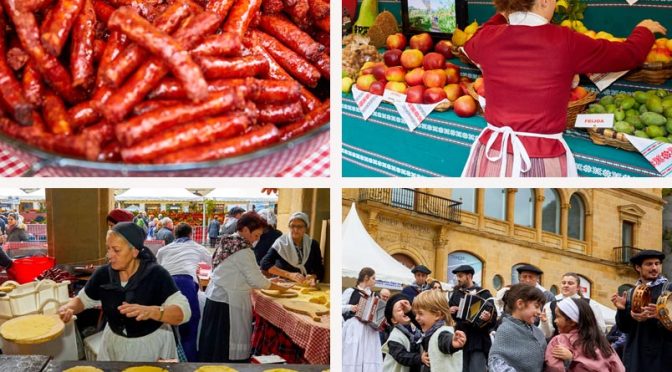One of the biggest events to open the Christmas season in the Basque Country is the Feria of Santo Tómas, a rural market in the heart of the city. Originating in Gipuzkoa – more specifically Donostia – it has spread as a celebration throughout the Basque Country. Today, the Feria is a celebration of rural Basque traditions. People pull out their baserritarrak costumes – dressing as aitxitxa and amuma – and celebrate the baserri way of life. But the origins lie in the tradition of collecting rents on this day…

- In olden times, December 21 was chosen as the date that renters had to go and pay their land lords. Why December 21? Well, the religious calendar guided people’s lives and the feast day of Saint Thomas was both close to Christmas and to the end of the year (I guess one implies the other…) It was far enough ahead of Christmas itself that people could get back home in time for the holiday. It seemed like a good day to collect the year’s payment.
- However, picking a specific date like this meant that a large number of people traveled to the cities to settle their accounts. This then led to opportunities to do some shopping, to buy goods and other things that were harder to find in their smaller outlying villages – things like nougats, trinkets and toys, and more exotic foods such as figs, pomegranates, and nuts. At the same time, the baserritarrak – the rural villagers – would bring their goods, primarily foodstuffs, to sell to the city dwellers. Out of this extra bustle came the Feria, the Fair, of Santo Tómas.
- The oldest mention is that of Donostia, in the early 1800s. However, given the fact that Donostia burned and lost many of its records in 1813, it is fair to think that the Feria had been going on for some time by then.
- The merchants of Donostia, seeing opportunity in the large number of visitors with money, took their wares to the street, assembling in the Plaza de la Constitución. Merchants began adding attractions to pull in prospective shoppers. Musicians and singers became part of the Fair. So did traditional athletes such as the harri-jasotzaileak, or stone-lifters.
- In the mid 1900s, the Feria experienced an existential crisis of sorts. It had turned into almost a carnival, in which all kinds of things were sold, not just traditional products but all sorts of things, such as masks and costumes and the like. However, it was decided to keep the more traditional character and those types of non-Basque, non-rural products were banned. Today, stalls sell a range of products from fruits and vegetables, to farming tools, with exhibitions of birds, livestock, flowers, and plants added more recently.
- Until the end of Franco’s regime, December 21 was one of two days on which it was allowed to present theater in the Basque language, the other being January 20, the Tamborrada.
- Food is a big part of the Feria. Traditionally, those landowners would give cod to their renters while those renters gave the owners, in turn, capons – a type of male chicken. However, today the txistorra dominates the festival. Maybe in the old days it was accompanied by roasted chestnuts but today talo, a corn flatbread sort of like a Mexican tortilla, is served with the txistorra. The perfect drink to go with the txistorra is a glass of cider.
- More recently, the Feria of Santo Tómas spread to other parts of the Basque Country. In particular, the Feria of Bilbo has become quite large and popular.
Primary sources: Sada Anguera, Javier María. Feria de Santo Tomás. Auñamendi Encyclopedia. Available at: https://aunamendi.eusko-ikaskuntza.eus/en/feria-de-santo-tomas/ar-154130/
Discover more from Buber's Basque Page
Subscribe to get the latest posts sent to your email.


